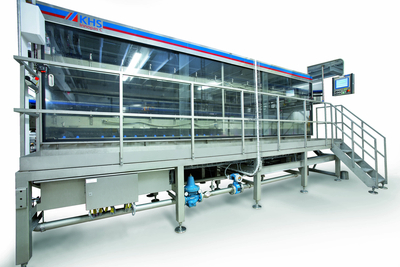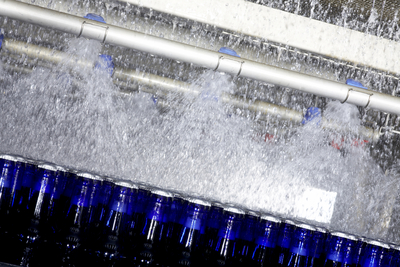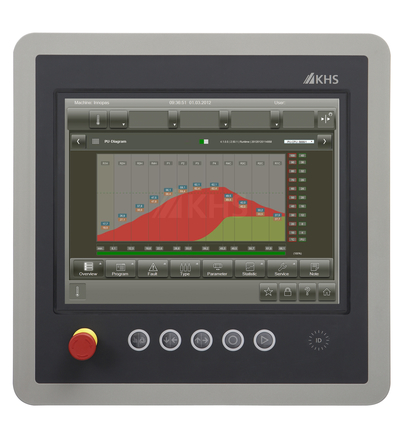
Extensive Package of Advantages
Optimized KHS pasteurization unit controllers offer a number of advantages
Frank Köppel* Knut Soltau** Aco Todoroski*** Every beverage producer wants to deliver top product quality and maximum shelf life to the consumer market. Full pasteurization in a tunnel pasteurizer provides one way of achieving that goal with different varieties of beer, mixed beer drinks, non-alcoholic beer, non-alcoholic soft drinks, and fruit juice. Controlled heating of the beverages following the filling process is a reliable method of killing germs. Maximum product safety is a given. To protect the beverage's flavor and valuable ingredients during the pasteurization process, it is crucial to have a pasteurization unit control system (PU control system) which adapts to the exact thermal characteristics of the products to be pasteurized and their containers. KHS introduced dynamic PU control technology in the mid 1990’s. Extensive optimization was recently made to these dynamic PU controllers, and the new design has a number of advantages. Dynamic PU control The previous approach was based on static temperature control with fixed temperature settings intended to place an upper limit on pasteurization units during line stoppages. In contrast, dynamic systems offer adaptive PU control. If a fault occurs during the pasteurization process, the process temperatures are kept under control in the hot zones of the tunnel pasteurizer to ensure maximum product safety and flavor stability. A prerequisite for exact PU control at all times is precise calculation of the product temperature at a defined reference point in the respective container. * Electrical Engineering Design Manager, Pasteurizing Technology Competence Center,KHS GmbH, Dortmund, Tel. +49 (231) 5 69-17 21 ** Product Management, Pasteurizing Technology Competence Center, KHS GmbH, Dortmund, Tel. +49 (231) 69-18 87 ***Software Div., Pasteurizing Technology Competence Center, KHS GmbH,
Dortmund, Tel. +49 (231) 5 69-16 74 Either the so-called cold spot (about 10 mm above the inner bottom of the container) or a spot located at 1/3 of the product filling level in the container is defined as the reference point. Mathematical-physical modeling can then be used to very accurately calculate the current PU values and also derive the PU values that are achievable in the process. Based on the results, the optimal spray temperature is continually determined to ensure that the temperature remains within the pre-defined limits and the achievable PU values are maintained when the containers exit from the pasteurization process. Over-pasteurization is reduced to a minimum even if multiple stop situations occur. PLC-based technology In contrast to the previous architecture, the latest-generation PU computer no longer runs on the machine console. KHS has made a conscious decision to segregate PU control used for quality assurance purposes from Windows-based visualization. The new PU computer consists of a PLC (programmable logic controller) which is suitable for industrial applications and has no moving parts. The PU operating system along with all customer-specific parameters is stored on a memory card. If a fault occurs on the PLC, only the PLC needs to be swapped. This was not the case with the industrial PC configurations, which were common in the past. The program and all specific parameters are transferred with the memory card, and the system is operational again right away. The usual problems encountered with replacement PCs such as old program versions and missing parameter updates are now history. The operating system is essentially an encapsulated program. This prevents unauthorized program modifications, ensuring maximum process reliability. Genuine real time response Industrial-grade controllers have other advantages as well. The PU computer is dedicated exclusively to the process, providing genuine real time control. The PU computer communicates directly with the machine controller. Modules which have nothing to do with PU control (e.g. statistical or temperature log data storage, PU control visualization, etc.) are not connected to the actual PU controller. Ideally, PU control data should be stored in a production data acquisition system so that the history of every pasteurization process can be recalled. Benchmark data is also available for logger measurements. Long service life, high spare parts availability Long service life and high spare parts availability are other major advantages of industrial-grade hardware on the PU controller. Direct access to the PU control system right from the workstation or desk Not only that, a Web interface is used for graphic display on the new PU controller, ensuring optimal display on multiple computers. Machine operators, the Engineering Manager and the lab team have direct on-demand access to the PU controller from their workstation or desk. This was not possible on Windows-based systems, which only supported display on a single computer. Additional control modules can be integrated into the pasteurization process independently of each other Optimization of the KHS PU controller was not limited to the highly useful features of the new PU control computer, which were described above. The general procedure on pasteurization projects is that either the customers themselves decide how many pasteurization units are needed for the product or they ask the experts at KHS for advice. A container program can handle multiple pasteurization parameters. Multi-spec control ensures that the process provides both the usual total number of PUs, which are normally counted starting at a threshold temperature of say 55°C, as well as minimum values for lethal PUs, which are added in at threshold temperatures starting at 60°C. Sometimes, the product has to be heated to a specific temperature for a precisely defined amount of time. This is mainly the case with fruit juice or beverages that contain fruit. A temperature-time module is used for these applications. The Total PU, Lethal PU, and Temperature-Time modules can be used together in a pasteurization program depending on the application. Naturally, a control system can be designed on request to manage special process parameters such as TDUs (Thermal Degradation Units, a measure of flavor change). KHS can provide advice on the best approach. The information provided by the customer on the products to be pasteurized, the containers they will be filled into, the pasteurization conditions, infeed and outlet temperatures and pasteurizer output capacity is absolutely essential. Using the Pasteurizer Designer program to configure the optimal pasteurizer A member of the KHS team assembles all of the data needed for the design and enters it into the Pasteurizer Designer program. The program then comes up with the design of an optimal pasteurizer, which meets all of the criteria. Once the virtual design is available, KHS and the customer can easily simulate other options. They can, for example, quickly determine how much longer the pasteurizer would need to be if the containers are warmer than specified at the infeed but still must not exceed the defined outlet temperature or what effect additional cooling inside the pasteurizer would have on the size of the pasteurizer. They can also model the ideal length and width of a pasteurizer, which will be installed in a building where the available space is limited by support columns. KHS also provides in-depth sustainability advice. The list of issues addressed includes the amount of energy and water that can be saved if the pasteurizer is connected to a cooling tower or if the EcoBuS method is used and how long the payback period is. The customer-specific energy and water prices are taken into consideration along with regional acceptance for particular types of systems and compatibility with sustainability strategies. Focusing on sustainability As is the case when a cooling tower is included in the pasteurizer system design, the EcoBuS method results in energy savings while still ensuring maximum pasteurization precision. If the EcoBuS method is used, the pasteurizer works in combination with three buffer tanks, which are integrated into the machine structure. Warm, hot, and cold process water is strictly separated and stored in the tanks. The EcoBus method is an intelligent system that reacts flexibly to operational and demand situations, for example in the event of gaps or stops during the pasteurization process. The warm and cold water buffers act like coupled batteries that keep charging and discharging each other as required. Experience shows that EcoBuS technology in the pasteurizer alone cuts fresh water consumption by up to 30% and heat energy consumption by 10%. A cooling tower and the EcoBuS method can be used together to further enhance sustainability. Simulation model successfully reflects real-world operation Once the size and configuration of the pasteurizer have been determined to achieve the defined process parameters, data from the Pasteurizer Designer can be automatically transferred to the PU control program, which will be used later on. Automatic transfer has obvious advantages including speed and high accuracy. Not only that, once the machine design has been defined, the customer can request a simulation of the pasteurization processes and determination of the resulting PUs. The simulation model successfully reflects real-world operation. The system can be used to quickly run through a simulated production day using a number of different start and stop scenarios. The customer receives an overview of the temperature and PU values achieved and ensured by KHS. Optional reduction … On request, the temperature in the pasteurization process can be lowered when stop situations occur. Normally, the product temperature is lowered to a point just below the defined PU threshold temperature if the pasteurization process is stopped. The temperature can also be reduced further to prevent flavor degradation to the maximum extent possible. During lengthy stoppages, the temperature of beer, for example, can be lowered to 45°C instead of 55°C. This additional temperature reduction has the disadvantage that it increases energy and water consumption. … flexible speed control The speed decrease option reduces machine stoppages when products back up or the supply of products is interrupted, saving energy and water. If the speed is changed in the pasteurizer, the spray temperatures are increased or decreased as appropriate for the transit time. This also considerably reduces machine stoppages and the associated water and energy consumption. … and BOT control BOT (Bottle Outlet Temperature) control is another optional feature. It defines the allowable range of outlet temperatures for the products. The containers should not be too cold when the labels are applied. Otherwise, condensation forms that could, for example, impair the labeling process. Excessive outlet temperatures can cause a change in product flavor even after the products are packed and while they are in storage. The controller is connected to a dew point temperature measurement device, which is installed in the line to determine the minimum allowable container outlet temperature, which ensures that condensation will not form. Extremely fast changeover In the past, the pasteurizer normally had to be completely emptied prior to product changeover. That had to take place before the next product entered the machine. There was only one temperature profile throughout the entire pasteurizer. Now, product changeover can take place very quickly. In practice, what customers normally want to do is process two different products in parallel in the pasteurizer while changeover is taking place. Fast product changeover has the advantage that changeover times on the entire line are reduced because the pasteurizer no longer acts as a bottleneck, which causes extended stoppages. Production time increases significantly while energy and water consumption decrease. There is another advantage associated with fast product changeover. The operator can see from the information on the monitor what needs to be done during changeover. In the past, an operator had to track containers from the filler to the pasteurizer to ensure that product separation takes place at the right moment, but that is no longer necessary. The operator can see on the monitor when the last container of one product type should be fed into or discharged from the pasteurizer. The operator has to acknowledge each product changeover. If the acknowledgement does not take place, the pasteurizer automatically enters the wait state. As a result, product separation is extremely reliable. Even after a power failure, the pasteurization process continues to run reliably Redundant data backup on the new PU control computer supports another new feature. Even after a power failure, the pasteurization process can be always be reliably resumed and generally without delay. On Windows computers, any data that was not saved prior to the power failure is lost. When that happens, it is best to start the pasteurization process over again. The PU computer on the other hand always knows which processes have already taken place. This avoids over-pasteurization, ensuring high flavor stability in the products. Excellent software protection Excellent software protection is another key advantage of the new PU controller. In the past, the standard method was to store the exact pasteurization sequence for the various products in data files. The files were read into the PU control system at product changeover. This methodology has the big disadvantage that the programs can be modified. Incorrect settings sometimes resulted in inadequate pasteurization. Once the data has been read into the new KHS PU control computer, no further manipulation is possible. This ensures that the pasteurization process always runs under optimal conditions, resulting in maximum product safety. During the development of new product type programs when changes are made to the pasteurization process, KHS is always ready to offer advice and provide new software without delay, which is tailored exactly to the product. Upgrade to new PU control system possible All of the advantages of the new PU control computer can also be made available on existing KHS pasteurization systems. Old for new replacement is simple and does not take much time. The old PU control system on the Windows PC is removed, the new hardware is installed, and a visualization update is provided. The new PU controller already has a good track record in the field. A number of pilot projects provide an excellent reference base. From the industry perspective, the new PU controller is seen to be extremely useful. Recent investment by a number of customers in new KHS pasteurization technology including the new PU computer is undoubtedly one indication of that. Other companies are very interested in retrofitting their existing pasteurizers.



